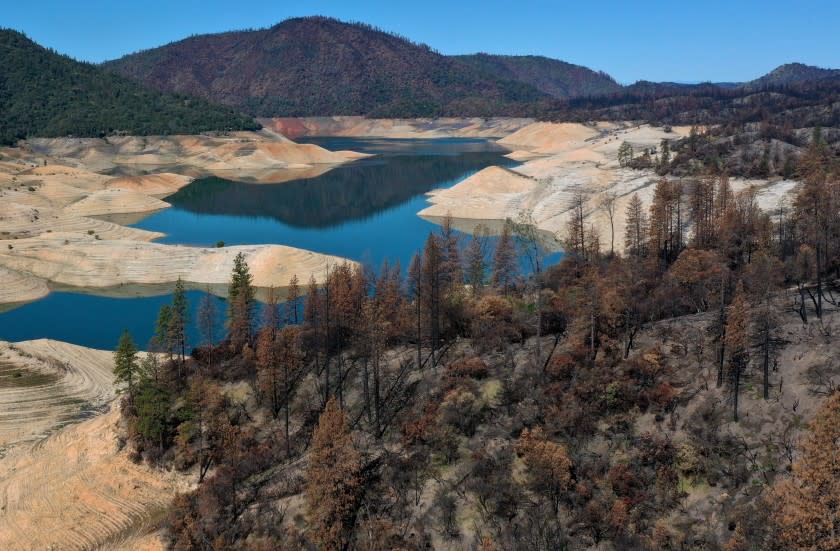Letters to the Editor: California, stop divvying up water like it's the Little Ice Age

To the editor: The Times Editorial Board recognizes that water policies developed on the heels of the Little Ice Age are not scientifically sound or sustainable for California. ("There is no drought," editorial, May 6)
Juan Cabrillo wrote of snowcapped mountains around Carmel when he sailed by in 1542, when the period of global cooling known as the Little Ice Age began. Juan Crespí wrote the principal diary of the 1769 Portolá expedition into California and reported that Indians on the southern end of the Santa Lucia Mountains in present-day Monterey County said they had deep winter snow.
My grandmother grew up a gold miner's daughter 120 years ago, when our water policies were developed. Her family lived on the southern ridge of the Yuba River above Downieville. They had several feet of snow every winter at 4,500 feet in elevation. We rarely have permanent winter snow at that elevation anymore.
People who believe we can use as much water as we want are basically spending our inheritance with no regard for the kids and grandkids. Farmers are pumping more water from our aquifers than is being replaced, causing permanent subsidence in the land. We cannot dam our way out of our historical aridity because we rarely fill the reservoirs we have.
It's time we learn to live within our means, and that means California is far drier that we previously thought.
Keith Ensminger, Merced, Calif.
..
To the editor: Thank you for your editorial. It is time for discussions of real solutions to California's climate and water crises. One such solution is reassessing water rights for large farms, which use 80% of the state's developed water supply.
So much "drought" reporting favors industrial agriculture. Even more "balanced" articles often quote farmers, fishermen, even environmentalists but ignore Native people and the estimated 1 million Californians who still lack access to clean water.
Who gets clean water in California is a social justice issue. California's water rights system was created before people of color could vote or own land. It is racist.
The climate crisis highlights the fact that California has to reassess its antiquated water-rights system. Cities, native people and rivers should not be without water while farmers flood their land.
Regina Chichizola, Orleans, Calif.
The writer is policy director for the group Save California's Salmon.
..
To the editor: "There is no drought" — surely The Times jests, I thought. Recurrent droughts, especially in Southern California, have been a staple in our history. As a historian of California, the pattern of droughts followed by sufficient precipitation is a familiar one.
When I finished reading this editorial, I concluded that statement was profound. The old climate pattern likely no longer holds here or anywhere else. Tornadoes are ravaging Louisiana, polar ice sheets are melting, and Kiribati and other Pacific isles are threatened by sea-level rise.
It's time we all connected the dots and realized history is turning a corner.
We must follow the science and dramatically reduce greenhouse gas emissions now. That means carbon pricing, community choice energy, electric or hydrogen fuel-cell vehicles, and no more fracking. The climate clock is ticking.
Tom Osborne, Laguna Beach
..
To the editor: Your headline "There is no drought" was misleading. If I'd been in more of a hurry, I might have scanned the headline, thought "that's a relief" and moved on.
OK, your point that our water shortage is not a temporary situation needing temporary fixes (some of which would worsen the situation) is important for us to understand. However, it's even more important for us to know how drastically we need to make appropriate changes.
Linda B. Nelson, Chatsworth
..
To the editor: I disagree with your opinion that because dry weather patterns are the new norm, we can no longer say we are in a drought.
Your thinking is based on human scales of time. Moisture will again return to our state, whether by torrential storms centuries from now or by saltwater intrusion caused by rising sea levels.
As a kid, I was fascinated by the fossil imprints of sea shells in the Santa Monica Mountains. It taught me to think in terms of millennia, not decades.
"Drought" is the best term we have to raise awareness of the fragility of our water supply, and it should be used to describe our new norm.
David Comden, Ventura
This story originally appeared in Los Angeles Times.

